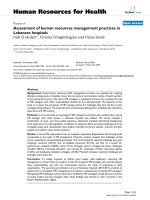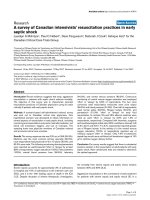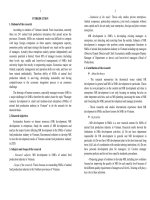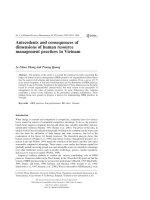Adoption of recommended potato production practices in Farrukhabad district (U.P.), India
Bạn đang xem bản rút gọn của tài liệu. Xem và tải ngay bản đầy đủ của tài liệu tại đây (231.22 KB, 9 trang )
Int.J.Curr.Microbiol.App.Sci (2017) 6(6): 3319-3327
International Journal of Current Microbiology and Applied Sciences
ISSN: 2319-7706 Volume 6 Number 6 (2017) pp. 3319-3327
Journal homepage:
Original Research Article
/>
Adoption of Recommended Potato Production Practices in
Farrukhabad District (U.P.), India
Amit Kumar Mishra1*, R. K. Dohrey2, Ravindra Kr Pandey3, Roop Kumar1,
Kshitij Parmar1 and R. K. Singh3
1
Department Agricultural Extension, SVBPUA & T Modipuram, Meerut (250110), India
2
Department Extension Education, NDUA & T Kumarganj, Faizabad (224229), India
3
Extension Education, NDUA & T Kumarganj, Faizabad (224229), India
*Corresponding author
ABSTRACT
Keywords
Potato growers,
Adoption and
Co-relation
Article Info
Accepted:
25 May 2017
Available Online:
10 June 2017
The present study was carried out during the year 2013-14 in Farrukhabad
district of central Uttar Pradesh. Total 100 respondents from these 5
villages were selected by using proporsnate random sampling technique
and data were collected by means of personal interview. The study revealed
that overwhelming majority (69.00 per cent) of potato grower’s had
medium of adoption of potato production technology. The study further
indicates that land holding, annual income, irrigation facilities, extension
participation, social participation, extension contact, scientific orientation,
risk orientation and knowledge had positive and highly significant
correlation with potato growers. While the variables like education,
experience and economic motivation had positive and significant
correlation of the potato growers.
Introduction
Potato (Solanum tuberosum L.) is one of the
major vegetable crops of the world. It is an
important crop grown in winter season in
plains of India its productivity varies
considerably between the regions, between
the area within a region and with the cultured
practices even at high fertility level. Among
the food crops, it ranks fourth in important
next only to rice, wheat and corn covering
about 21.22 million hectare and fifth in
production yielding about 309.5 million tones
after sugarcane, rice and maize. The original
home of Potato is Andean plateau of South
America. Potato is a most useful and
important member of the family solanacea
and it belong to genus Solanum, consist of
seven cultivated and about 154 wild species
but the commercially valuable potato has only
two species i.e. Solanum andignum and
Solanum tuberosum. It has special value as
food apart from starch which is rich source; it
also provides
Essential body building substance such as
vitamins, minerals and protein. Thus potato is
one of the richest sources of calories needed
3319
Int.J.Curr.Microbiol.App.Sci (2017) 6(6): 3319-3327
to maintain day to day output of human
energy per 200 gm. of edible portion of potato
contain 22.6 gm. carbohydrate, 1.6 gm.
Protein, 10 gm. calcium, 20 gm. magnesium,
247 gm. potassium, 17 gm. vitamin and 1.2
gm. nicotinic acid. It provides 87 gm. calories
to human body. Potato can be cooked in many
ways; they can be boiled, fried, roasted, baked
or steamed, they can also be possessed into
flakes, cubes, granules, chips, pan cakes etc.
They are good for breakfast, lunch and dinner.
Keeping in view the above facts, it was aimed
to study the socio economic status of the
Potato growers in Farrukhabad district of U.P.
Materials and Methods
This study was conducted in Farrukhbad
district during the year 2013-14. Farrukhbad
district comprise of 7 blocks in which one
blocks namely Kayamganj were purposively
selected. Five villages from Kayamganj
blocks were purposively selected and 100
potato growers were selected from all
villages. Thus the total sample size was of
100 respondents. The data were collected
through personal interview with the help of
pre structured schedule. The data were
analyzed and find out the percentage and rank
order.
Results and Discussion
The adoption process is the mental process
through which an individual passes from first
hearing of an innovation to its final adoption,
while adoption is a decision to continue the
full use of an innovation. Generally, the
farmers do not adopt package of practices
fully. There is only a partial adoption by
them. As a result, the gap always appears
between the recommended production
technology and their use at farmer’s field.
With a view to find out the extent of adoption
of recommended practices of potato
cultivation, the potato growers were asked to
give information about package of practices
adopted by them. The data regarding extent of
adoption are given in Table 1.
It is clear from Table 1. That majority of the
potato growers (69.00 per cent) had medium
level of adoption, followed by high (23.00 per
cent) and low (8.00 per cent). It revealed that
great majority (69.00 per cent) of potato
growers in study area had medium to high
level of adoption of recommended production
technology of potato.
Practice wise adoption of recommended
potato production technology by potato
growers: With a view to find out the practice
wise adoption of recommended practices of
potato cultivation, the potato growers were
asked to give information about package of
practices adopted by them. The data regarding
this are given in Table. Data in Table 2 shows
that among the different recommended potato
production technologies followed by Seed
rate (75.00 per cent), Sowing time (65.00 per
cent), Field preparation (64.00 per cent),
Amount of manures and fertilizers (53.00 per
cent), Improved varieties (50.00 per cent),
Time of application of manures and fertilizers
(47.00), Irrigation (43.00 per cent), Inter
cultural operations (40.00 per cent), Harvest
and post-harvest technology (38.00 per cent),
Plant protection measures (37.00 per cent),
Spacing (31.00 per cent) and Seed treatment
(21.00 per cent. Higher level of adoption due
to good farming experience, medium to high
literacy level and potato crop has been
cultivated by majority of farmers in
farrukhbad district for many years. Lower
level of adoption might be due to poor
knowledge about some practices, unsuitability
of technology in their own situation, higher
cost and complexity of technology.
It is evident from the Table.1 that Maximum
numbers of respondent (30%) were reported
that they did adopt normal sowing varieties.
3320
Int.J.Curr.Microbiol.App.Sci (2017) 6(6): 3319-3327
The rest of respondents were reported using
late sowing varieties (15%) and early sowing
varieties (5%). Therefore, it is is said that the
farmers of this area rarely use the improved
varieties of potato.
The Table.2 indicates the position of field
prepration by the respodents. First ploughings
time of potato observed (40%) and before
sowing of potato seed, how many plounging
(24%) respectively. Hence it may be aid that
field prepration many potato grower adopt.
It is evident from the Table.3 that Maximum
numbers of respondent (50%) were reported
that they did adopt for normal sowing. The
rest of respondents were reported using for
late sowing (15%) and for early sowing
therefore, it is said that the farmers of this
area rarely use scientific seed rate of potato.
The data presented Table.4 that maximum
number of respondents (15%) reported that
their adopt hormone for seed treatment and
how much are followed by (5%) and
respondents adopted how many hour before
sowing, treated the seed with hormone (1%)
respondents respectively.
It is evdent from the Table.5 that Maximum
number of respondent (30%) were reported
that they din adopt for normal sowing. The
rest of respondents were reported using for
late sowing (255%) and for early sowing
(10%). Therefore, it is said that the farmers of
this area rarely use scientific time of sowing
of potato.
Table.1 Distribution of the respondent according to overall adoption
(N=100)
S.No.
Categories (age)
1.
2.
3.
Low (up to 8)
Medium (9-16)
High (17-24)
Total
Number of
respondent
8
69
23
100
Percent
8.00
69.00
23.00
100.00
Table.2 Practice wise adoption of recommended potato production technology by potato growers
S.No.
1.
2.
3.
4.
5.
6.
7.
8.
9.
10.
11.
12.
Practices
Field preparation
Seed rate
Time of application of manures and
fertilizers
Harvest and post-harvest technology
Sowing time
Irrigation
Spacing
Amount of manures and fertilizers
Inter cultural operations
Seed treatment
Improved varieties
Plant protection measures
3321
Number of
respondents
64
75
47
Percentage
38
65
43
31
43
40
21
50
37
38.00
65.00
43.00
31.00
53.00
40.00
21.00
50.00
37.00
64.00
75.00
47.00
Int.J.Curr.Microbiol.App.Sci (2017) 6(6): 3319-3327
Table.3 Distribution of respondents according to adoption extent
About improved varieties Potato
N=100
S.No.
Categories
Respondents
No.
Percentage
Early sowing varieties
05
5.00
1.
Normal sowing varieties
30
30.00
2.
Late sowing varieties
15
15.00
3.
Total
50
50.00
Table.4 Distribution of respondents according to adoption extent of field preparation
N=100
S.No. Categories
Respondents
No.
Percentage
When did you plough your potato field first
40
40.00
1.
Before sowing of potato seed, how many
24
24.00
2.
ploughings did you do
Total
64
64.00
Table.5 Distribution of respondents according to adoption extent of seed rate
N=100
S.No. Categories
Respondents
No.
Percentage
For early sowing
10
18.00
1.
For normal sowing
50
48.00
2.
For late sowing
15
34.00
3.
Total
75
75.00
Table.6 Distribution of respondents according to adoption extent of seed treatment
N=100
S.No.
Categories
Respondents
No.
Percentage
Which fungicide did you apply to treat the potato
15
15.00
1.
seed?
How much Fungicide did you use to treat one kg
05
5.00
2.
of seed?
For how many hours before sowing, you treated
01
1.00
3.
the seed with fungicide?
Total
21
100.00
Table.7 Distribution of respondents according to adoption extent of time of sowing
N=100
S.No.
Categories
Respondents
No.
Percentage
Early sowing
10
10.00
1.
Normal sowing
30
30.00
2.
Late sowing
25
25.00
3.
Total
65
65.00
3322
Int.J.Curr.Microbiol.App.Sci (2017) 6(6): 3319-3327
Table.8 Distribution of respondents according to adoption extent of spacing
N=100
S.No.
1.
2.
3.
Total
Categories
Respondents
No.
Percentage
15
15.00
03
3.00
13
13.00
31
31.00
Row to row
Plant to plant
Depth
Table.9 Distribution of respondents according to adoption extent of manures and fertilizers
N=100
S.No.
Categories
Respondents
No.
Percentage
Manures are applied which and how much
10
10.00
1.
Fertilizers are applied which and how much
30
30.00
2.
Total
43
43.00
Table.10 Distribution of respondents according to adoption extent of
Time of application of manures and fertilizers
N=100
S.No.
1.
2.
Categories
No.
10
37
47
FYM & Compost
NPK & Sulphur
Total
Respondents
Percentage
10.00
37.00
47.00
Table.11 Distribution of respondents according to adoption extent of irrigation
N=100
S.No.
Categories
1.
2.
At which time did you irrigate first?
At which critical stage, you irrigate tour crop
(days)?
Total
Respondents
No.
Percentage
23
23.00
20
20.00
43
43.00
Table.12 Distribution of respondents according to extent of intercultural operations
N=100
S.No.
1.
2.
3.
Categories
No.
20
10
10
40
Basalin
Metribusin
Pendimethyl
Total
3323
Respondents
Percentage
20.00
10.00
10.00
40.00
Int.J.Curr.Microbiol.App.Sci (2017) 6(6): 3319-3327
Table.13 Distribution of respondents according to extent of plant protection measures
N=100
S.No.
Categories
Respondents
No.
Percentage
Actara and Plenum
07
7.00
1.
Monocrotofash 35Ec
20
20.00
2.
Aqequate
10
10.00
3.
37
37.00
Total
Table.14 Distribution of respondents according to adoption extent of
Harvest and post-harvest technology
N=100
S.No.
1.
2.
3.
Categories
Respondents
No.
Percentage
05
5.00
20
20.00
10
10.00
35
35.00
Early maturity
Normal maturity
Late maturity
Total
Table.15 Relationship between the characteristics of potato growers and their level adoption of
recommended technology of potato crop
S. No.
1.
2.
3.
4.
5.
6.
7.
8.
9.
10.
11.
12.
13.
14.
15.
Independent Variables
Age
Education
Caste
Family type
Family size
Housing pattern
Land holding
Occupation
Annual income
Material possession
Social participation
Extent of contact with information sources
Scientific orientation
Economic motivation
Risk orientation
Correlation coefficient
-0.43035**
0.776637**
0.320652**
0.084515
0.055022
0.204595*
0.087431
0.197532*
0.247021*
0.288649**
0.129953
0.163852
0.138498
0.176527
-0.061
*Significant at 0.05% probability level 0.197, ** Significant at 0.01% probability level 0.257
3324
Int.J.Curr.Microbiol.App.Sci (2017) 6(6): 3319-3327
Fig.1 Respondent according to overall adoption
Fig.2 Practice wise adoption of recommended potato production technology by potato growers
It is evdent from the Table.6 that Maximum
number of respondent (15%) were reported
that they din adopt for Row to row spacing.
The rest of respondents were reported using
for depth (13%) and for plant to plant spacing
(3%). Therefore, it is said that the farmers of
this area rarely use scientific spacing of
potato.
The data presented Table.7 that maximum
number of respondents (30%) reported that
adopt their scientific fertilizer quantity and
3325
Int.J.Curr.Microbiol.App.Sci (2017) 6(6): 3319-3327
scientific manures quantity are followed by
(13%) respondents respectively.
The data presented Table.8 that maximum
number of respondents (37%) their adopt
NPK & Compost and adopted FYM &
Compost, time of application of manures and
fertilizers (10%) respondents respectively.
It is obvious from the Table.9 over whiling
majority (23%) of the respondents was
adopting the timely irrigation and (20%)
respondents timely give critical stage
irrigation.
The Table.10 shows that the adopt extent of
intercultural operation. On an average the
maximum number of respondents (20%) were
adopt the Basalin and (10%) respondents
Metribusin and pendimethyl are equally.
The Table.11 shows that the adopt extent of
plant protection. On an average the maximum
number of respondents (20%) were adopt the
Monocrotofash, (10%) and (7%) respondent’s
view of Aqequate and Actara and Plenum,
respectively.
correlation with adoption of the potato
growers. While the variables like Family type,
Family
size,
Land
holding,
Social
participation, Extent of contact with
information sources, Scientific orientation and
Economic motivation showed positive and
non-significant and Risk orientation showed
non- significant correlation with adoption of
recommended production technology of
potato.
In conclusion, the study revealed that majority
of the potato growers belonged to medium
level of adoption. Most of potato growers
were found in non-adaptor category in respect
of certain important items like Seed rate,
Sowing time and Field preparation. All the
selected attributes of the potato grower’s
except age, education and caste showed
positive and significant correlation with their
adoption level. So as to enhance adoption
level, it is necessary to involve the farmers in
extension education programme. It would
facilitate the dissemination of recent
Practices.
Acknowledgement
It is evident from the Table.12 that Maximum
number of respondent (20%) were adopted
that they din adopt normal maturity. The rest
of respondents were reported using late
maturity (10%) and early maturity (5%).
Therefore, it is is said that the farmers of this
area rarely use the harvest and post-harvest
technology of potato.
Author is thankful to Dr. R.K. Dohrey,
Professor and Head, Department of Extension
Education, NDUA&T Kumarganj, Faizabad 224229 (U.P.) India for his kind guidance,
motivation and unconditional support for this
work.
The data with regard to relationship of
independent variable with adoption are
presented in Table 15 reflect that the
independent variables like Age, education,
caste and Material possession, had positive
and highly significant correlation with
adoption of potato growers. While the
variables like Annual income, occupation and
Housing pattern had positive and significant
Peer, Q. J. A; Satesh Kumar Aziz, M. A;
Jasvinder Kaur Chesti, M. H. and Anil
Bhat (2014). Adoption behaviour of
potato growers in sub-tropical zone of
Jammu division. African Journal of
Agricultural Research, 9(2):202-205.
Pandit, Arun. Rana, K. Anil. Pandey, R. K. K,
N. and Kumar, N. R. (2010). A study on
socio-economic profile of potato
References
3326
Int.J.Curr.Microbiol.App.Sci (2017) 6(6): 3319-3327
farmers: comparison of irrigated and
rainfed conditions in Himachal Pradesh.
Tropical Agricultural Research and
Extension; 41(8):69-74
Khalil, M. I; Haque, M. E. and Hoque, M. Z.
(2013).
Adoption
of
BARI
recommended
potato
(Solanum
tuberosum) varieties by the potato
farmers
of
Bangladesh.
The
Agriculturists, 11(2):79-86.
Namwata, B. M. L; Lwelamira, J. and Mzirai,
O. B. (2010). Adoption of improved
agricultural technologies for Irish
potatoes (Solanum tuberosum) among
farmers in Mbeya Rural district,
Tanzania: a case of Ilungu ward.
Journal of Animal and Plant Sciences
(JAPS); 8(1):927-935. 30
Madhuprasad, V. L; Kumar, G. V. M;
Venkataramana, P. and Muniswamappa,
M. V. (2002). Survey on adoption of
potato storage practices in Kolar
District.Current Research - University
of Agricultural Sciences (Bangalore);
31(5/6):91-93.
How to cite this article:
Amit Kumar Mishra, R. K. Dohrey, Ravindra Kr Pandey, Roop Kumar, Kshitij Parmar and
Singh R. K.. 2017. Adoption of Recommended Potato Production Practices in Farrukhabad
District (U.P.), India. Int.J.Curr.Microbiol.App.Sci. 6(6): 3319-3327.
doi: />
3327









